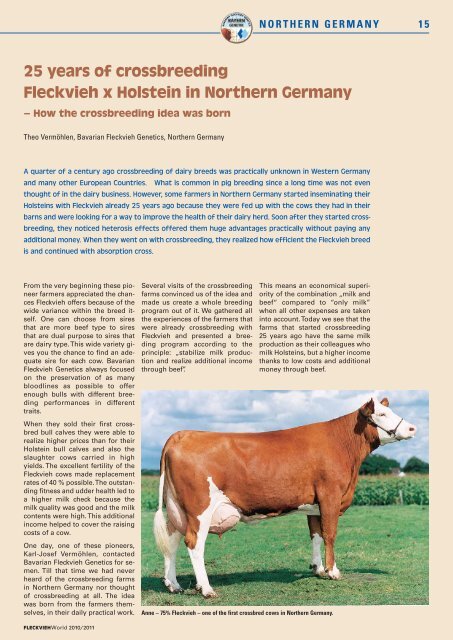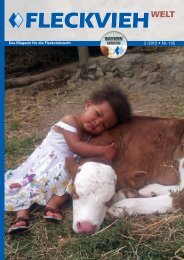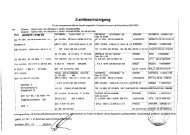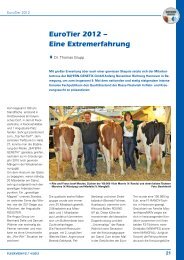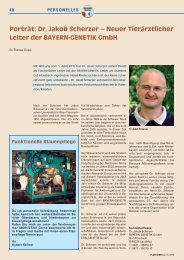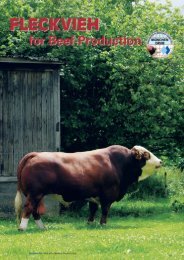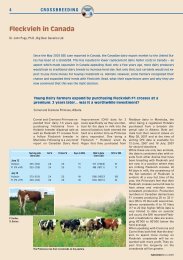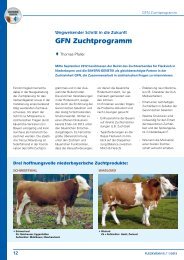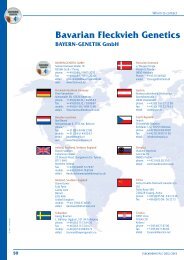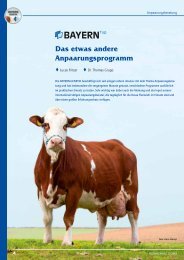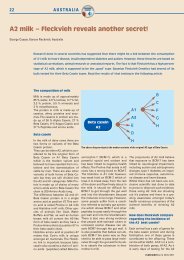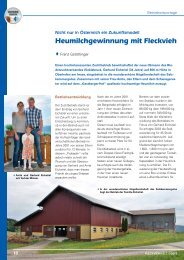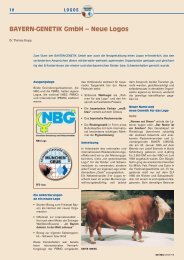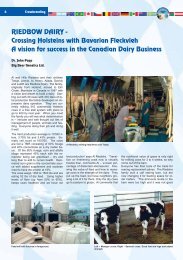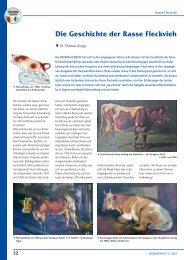25 years of crossbreeding Fleckvieh x Holstein in Northern Germany
25 years of crossbreeding Fleckvieh x Holstein in Northern Germany
25 years of crossbreeding Fleckvieh x Holstein in Northern Germany
Create successful ePaper yourself
Turn your PDF publications into a flip-book with our unique Google optimized e-Paper software.
FLECKVIEHWorld 2010/2011<br />
NORTHERN GERMANY 15<br />
<strong>25</strong> <strong>years</strong> <strong>of</strong> <strong>crossbreed<strong>in</strong>g</strong><br />
<strong>Fleckvieh</strong> x <strong>Holste<strong>in</strong></strong> <strong>in</strong> <strong>Northern</strong> <strong>Germany</strong><br />
– How the <strong>crossbreed<strong>in</strong>g</strong> idea was born<br />
Theo Vermöhlen, Bavarian <strong>Fleckvieh</strong> Genetics, <strong>Northern</strong> <strong>Germany</strong><br />
A quarter <strong>of</strong> a century ago <strong>crossbreed<strong>in</strong>g</strong> <strong>of</strong> dairy breeds was practically unknown <strong>in</strong> Western <strong>Germany</strong><br />
and many other European Countries. What is common <strong>in</strong> pig breed<strong>in</strong>g s<strong>in</strong>ce a long time was not even<br />
thought <strong>of</strong> <strong>in</strong> the dairy bus<strong>in</strong>ess. However, some farmers <strong>in</strong> <strong>Northern</strong> <strong>Germany</strong> started <strong>in</strong>sem<strong>in</strong>at<strong>in</strong>g their<br />
<strong>Holste<strong>in</strong></strong>s with <strong>Fleckvieh</strong> already <strong>25</strong> <strong>years</strong> ago because they were fed up with the cows they had <strong>in</strong> their<br />
barns and were look<strong>in</strong>g for a way to improve the health <strong>of</strong> their dairy herd. Soon after they started <strong>crossbreed<strong>in</strong>g</strong>,<br />
they noticed heterosis effects <strong>of</strong>fered them huge advantages practically without pay<strong>in</strong>g any<br />
additional money. When they went on with <strong>crossbreed<strong>in</strong>g</strong>, they realized how efficient the <strong>Fleckvieh</strong> breed<br />
is and cont<strong>in</strong>ued with absorption cross.<br />
From the very beg<strong>in</strong>n<strong>in</strong>g these pioneer<br />
farmers appreciated the chances<br />
<strong>Fleckvieh</strong> <strong>of</strong>fers because <strong>of</strong> the<br />
wide variance with<strong>in</strong> the breed itself.<br />
One can choose from sires<br />
that are more beef type to sires<br />
that are dual purpose to sires that<br />
are dairy type. This wide variety gives<br />
you the chance to f<strong>in</strong>d an adequate<br />
sire for each cow. Bavarian<br />
<strong>Fleckvieh</strong> Genetics always focused<br />
on the preservation <strong>of</strong> as many<br />
bloodl<strong>in</strong>es as possible to <strong>of</strong>fer<br />
enough bulls with different breed<strong>in</strong>g<br />
performances <strong>in</strong> different<br />
traits.<br />
When they sold their first crossbred<br />
bull calves they were able to<br />
realize higher prices than for their<br />
<strong>Holste<strong>in</strong></strong> bull calves and also the<br />
slaughter cows carried <strong>in</strong> high<br />
yields. The excellent fertility <strong>of</strong> the<br />
<strong>Fleckvieh</strong> cows made replacement<br />
rates <strong>of</strong> 40 % possible. The outstand<strong>in</strong>g<br />
fitness and udder health led to<br />
a higher milk check because the<br />
milk quality was good and the milk<br />
contents were high. This additional<br />
<strong>in</strong>come helped to cover the rais<strong>in</strong>g<br />
costs <strong>of</strong> a cow.<br />
One day, one <strong>of</strong> these pioneers,<br />
Karl-Josef Vermöhlen, contacted<br />
Bavarian <strong>Fleckvieh</strong> Genetics for semen.<br />
Till that time we had never<br />
heard <strong>of</strong> the <strong>crossbreed<strong>in</strong>g</strong> farms<br />
<strong>in</strong> <strong>Northern</strong> <strong>Germany</strong> nor thought<br />
<strong>of</strong> <strong>crossbreed<strong>in</strong>g</strong> at all. The idea<br />
was born from the farmers themselves,<br />
<strong>in</strong> their daily practical work.<br />
Several visits <strong>of</strong> the <strong>crossbreed<strong>in</strong>g</strong><br />
farms conv<strong>in</strong>ced us <strong>of</strong> the idea and<br />
made us create a whole breed<strong>in</strong>g<br />
program out <strong>of</strong> it. We gathered all<br />
the experiences <strong>of</strong> the farmers that<br />
were already <strong>crossbreed<strong>in</strong>g</strong> with<br />
<strong>Fleckvieh</strong> and presented a breed<strong>in</strong>g<br />
program accord<strong>in</strong>g to the<br />
pr<strong>in</strong>ciple: „stabilize milk production<br />
and realize additional <strong>in</strong>come<br />
through beef”.<br />
This means an economical superiority<br />
<strong>of</strong> the comb<strong>in</strong>ation „milk and<br />
beef“ compared to “only milk”<br />
when all other expenses are taken<br />
<strong>in</strong>to account. Today we see that the<br />
farms that started <strong>crossbreed<strong>in</strong>g</strong><br />
<strong>25</strong> <strong>years</strong> ago have the same milk<br />
production as their colleagues who<br />
milk <strong>Holste<strong>in</strong></strong>s, but a higher <strong>in</strong>come<br />
thanks to low costs and additional<br />
money through beef.<br />
Anne – 75% <strong>Fleckvieh</strong> – one <strong>of</strong> the first crossbred cows <strong>in</strong> <strong>Northern</strong> <strong>Germany</strong>.
16 FLECKVIEH WORLDWIDE<br />
First <strong>Fleckvieh</strong> calves born <strong>in</strong> Kenya<br />
Kenya is crazy about <strong>Fleckvieh</strong> s<strong>in</strong>ce<br />
Gerard Bessel<strong>in</strong>g, a Dutch guy liv<strong>in</strong>g<br />
<strong>in</strong> Kenya and his <strong>Fleckvieh</strong><br />
team <strong>in</strong>troduced the breed <strong>in</strong> the<br />
African country. Meanwhile the first<br />
<strong>Fleckvieh</strong> calves are on the ground,<br />
among these a set <strong>of</strong> tw<strong>in</strong>s, which<br />
is very seldom <strong>in</strong> Kenya.<br />
The lives <strong>of</strong> Gerard Bessel<strong>in</strong>g and<br />
his Kenyan wife Lydia changed a lot<br />
s<strong>in</strong>ce their company „<strong>Fleckvieh</strong> Genetics<br />
East Africa“ became the representative<br />
<strong>of</strong> Bavarian <strong>Fleckvieh</strong><br />
Genetics <strong>in</strong> summer 2009. Before,<br />
they had almost noth<strong>in</strong>g to do with<br />
agriculture <strong>in</strong> Kenya, now they have<br />
a farm that everybody knows<br />
and that is highly respected. Together<br />
with a team <strong>of</strong> specialists and<br />
veter<strong>in</strong>arians they <strong>in</strong>troduce <strong>Fleckvieh</strong><br />
<strong>in</strong> Kenya and other Middle<br />
African countries. Meanwhile the<br />
first calves were born and the enthusiasm<br />
is constantly ris<strong>in</strong>g.<br />
George Cassar, our representative<br />
<strong>in</strong> Australia had some ear tags made<br />
up to distribute to users <strong>of</strong> <strong>Fleckvieh</strong><br />
semen to tag F1 (50 % Flekkvieh)<br />
calves sent to the saleyards<br />
<strong>in</strong> order to create a bigger exposure<br />
and awareness and a higher demand<br />
for <strong>Fleckvieh</strong>. Currently bull<br />
calves make about $ 45 and Jersey<br />
„Nearly every day we get<br />
SMS and emails from<br />
Kenyan farmers about the<br />
birth <strong>of</strong> <strong>Fleckvieh</strong> crossbreds.<br />
<strong>Fleckvieh</strong> is used on<br />
<strong>Holste<strong>in</strong></strong>, Guernsey, Jersey<br />
and Zebu cows. The calves<br />
are born without any complications.<br />
They are very vital<br />
and their fast growth is<br />
remarkable. <strong>Fleckvieh</strong> is<br />
very valuable for big dairy<br />
farms, but also for small<br />
farmers who have only one<br />
or two cows <strong>in</strong> their barn.<br />
And don’t forget that most<br />
<strong>of</strong> the Kenyan farmers belong<br />
to the Massai and<br />
they are real cow-people”<br />
says Gerard Bessel<strong>in</strong>g <strong>in</strong><br />
Nairobi.<br />
Apart from their <strong>Fleckvieh</strong> bus<strong>in</strong>ess<br />
Gerard Bessel<strong>in</strong>g and his wife Lydia<br />
run a company <strong>in</strong> Nairobi named<br />
<strong>Fleckvieh</strong> Ear Tags <strong>in</strong> Australia<br />
bull calves are added to the compost<br />
heap.The ear tags already celebrated<br />
their first success: Greg<br />
Templeton, who was one <strong>of</strong> the first<br />
to use the ear tags wrote to George<br />
Cassar:<br />
„Hi George, sold my first calf<br />
yesterday wear<strong>in</strong>g a <strong>Fleckvieh</strong> tag,<br />
it must have worked because he<br />
South African Cheese Festival 2010<br />
Thys Swart from Kykso Simmentalers and Dr. Thomas Grupp from Bavarian<br />
<strong>Fleckvieh</strong> Genetics are proud <strong>of</strong> the award for the <strong>Fleckvieh</strong> booth.<br />
Mary K<strong>in</strong>guru from Ihwage (near Mount Kenya) is proud <strong>of</strong> the <strong>Fleckvieh</strong> tw<strong>in</strong>s<br />
out <strong>of</strong> her Guernsey cow. She also has a <strong>Holste<strong>in</strong></strong> cow that is due to a <strong>Fleckvieh</strong><br />
sire.<br />
Amicabre, that organizes safaris<br />
and passenger transportation.<br />
300 people are employed <strong>in</strong> that<br />
company.<br />
made $ 232 and the auctioneer<br />
didn’t hesitate<br />
us<strong>in</strong>g the name and I<br />
watched a number<br />
<strong>of</strong> people have a<br />
look and turn his<br />
ear so they could<br />
read it, so away we<br />
go!”<br />
Thousands <strong>of</strong> cheese lovers from<br />
near and far celebrated the Good<br />
Life at the 2010 South African Cheese<br />
Festival earlier this year. 8.000<br />
people per day attended the festival<br />
that lasted for four days. The<br />
number <strong>of</strong> visitors is limited to<br />
8.000, which is part <strong>of</strong> the success<br />
<strong>of</strong> this event.<br />
In the year 2009 <strong>Fleckvieh</strong> was exhibited<br />
at the festival for the first time.<br />
Enthusiastic <strong>Fleckvieh</strong> breeders<br />
from the Western Cape Simmentaler<br />
Club and Bavarian <strong>Fleckvieh</strong><br />
Genetics <strong>in</strong>troduced the breed<br />
to the broad public. A Hippo daughter<br />
(100 % FV) and a Randy daughter<br />
(50 % FV / 50 % <strong>Holste<strong>in</strong></strong>) were<br />
exhibited as liv<strong>in</strong>g examples. Everybody<br />
was very happy when the<br />
<strong>Fleckvieh</strong> booth was awarded best<br />
booth <strong>in</strong> the category „Milk factory“.<br />
In 2010 aga<strong>in</strong> a pure <strong>Fleckvieh</strong> cow<br />
and a <strong>Fleckvieh</strong>/Ayrshire crossbred<br />
were shown. To our great surprise<br />
the booth was awarded best booth<br />
for the second time <strong>in</strong> a row.<br />
In 2011 the South African Cheese<br />
Festival celebrates its 10th anniversary.<br />
It will take place from the 29th<br />
<strong>of</strong> April to 2nd <strong>of</strong> May 2011. <strong>Fleckvieh</strong><br />
will be back with an even better<br />
exhibition concept! Come and<br />
see us!<br />
FLECKVIEHWorld 2010/2011
First <strong>Fleckvieh</strong> cows<br />
at World Dairy Expo, Madison/USA<br />
Johanna Kampschulte, Theo Vermöhlen<br />
Thanks to the <strong>crossbreed<strong>in</strong>g</strong> research<br />
trials <strong>of</strong> Pr<strong>of</strong>. Les Hansen <strong>in</strong><br />
California and M<strong>in</strong>nesota and the<br />
long-time work and experience <strong>of</strong><br />
Bavarian <strong>Fleckvieh</strong> Genetics <strong>in</strong> this<br />
subject, <strong>Fleckvieh</strong> x <strong>Holste<strong>in</strong></strong> crossbreds<br />
become more and more popular<br />
<strong>in</strong> North America.<br />
In the year 2009, for the first time,<br />
crossbred animals were admitted<br />
to the famous fair at Madison. In<br />
the „Graz<strong>in</strong>g Pavilion“ they were<br />
shown to the public. Besides the<br />
crossbred <strong>Fleckvieh</strong> cows, the<br />
Dutch Belted and Normande<br />
Breeds were also exhibited, along<br />
with an array <strong>of</strong> <strong>in</strong>formation on<br />
graz<strong>in</strong>g related products and ideas.<br />
Ale Riedstra from Riedbow Dairy <strong>in</strong><br />
Manitoba/Canada, the breeder <strong>of</strong><br />
the cows, and Cornel Primrose, a<br />
<strong>Fleckvieh</strong> breeder and friend from<br />
Alberta, took the drudgery upon<br />
themselves to make the long trip<br />
from Canada to br<strong>in</strong>g the cows to<br />
Regio-daughter (75 % <strong>Fleckvieh</strong>, DS: Enrico), exhibited at World Dairy<br />
Expo 2009. Production: 1 st. La., 66 days: 1790 – 4,67 – 3,02.<br />
FLECKVIEHWorld 2010/2011<br />
the fair. Together with our North<br />
American distributor, Dr. John<br />
Popp, they had selected three<br />
cows, two Regio-daughters with<br />
50 % and 75 % <strong>Fleckvieh</strong> blood and<br />
one Waterberg-daughter with 75 %<br />
<strong>Fleckvieh</strong> blood.<br />
On the show grounds the animals<br />
were prepared for their debut at<br />
World Dairy Expo by a pr<strong>of</strong>essional<br />
cow fitter. The results were three<br />
perfectly styled ambassadresses<br />
for the <strong>Fleckvieh</strong> breed. Despite <strong>of</strong><br />
their long journey to Madison, the<br />
<strong>Fleckvieh</strong> cows – all <strong>in</strong> their first<br />
lactation – presented themselves<br />
excellently and attracted lots <strong>of</strong> attention.<br />
Milk production on the<br />
cows rema<strong>in</strong>ed unchanged dur<strong>in</strong>g<br />
the show and all three cows conv<strong>in</strong>ced<br />
through their excellent type<br />
traits, udder quality and high production.<br />
Accord<strong>in</strong>gly, the <strong>in</strong>terest<br />
from the visitors was enormous<br />
and the people who took care <strong>of</strong><br />
WORLD DAIRY EXPO 17<br />
The exhibition <strong>of</strong> the first live <strong>Fleckvieh</strong> cows at last year’s World Dairy Expo <strong>in</strong> Madison, USA, the most important<br />
meet<strong>in</strong>g po<strong>in</strong>t <strong>of</strong> the dairy <strong>in</strong>dustry, where the best north American <strong>Holste<strong>in</strong></strong>, Red & White, Jersey,<br />
Guernsey, Brown Swiss, Ayrshire and milk<strong>in</strong>g Shorthorn cows are presented to a huge number <strong>of</strong> <strong>in</strong>ternational<br />
visitors, was a historical event for Bavarian <strong>Fleckvieh</strong> Genetics and the whole <strong>Fleckvieh</strong> breed.<br />
the animals, Ale Riedstra, Cornel<br />
Primrose and Karyn Cassar had<br />
their hands full with answer<strong>in</strong>g all<br />
the questions.<br />
North American farmers like the<br />
functionality <strong>of</strong> the crossbred<br />
cows. They show lots <strong>of</strong> substance<br />
and stand out through their fitness<br />
and surpris<strong>in</strong>g high milk yields. The<br />
excellent fertility and udder health<br />
are highly appreciated. Producers<br />
us<strong>in</strong>g Bavarian <strong>Fleckvieh</strong> for cross<strong>in</strong>g<br />
see added revenue from the<br />
sale <strong>of</strong> male calves and when hav<strong>in</strong>g<br />
to cull <strong>Fleckvieh</strong> crosses.<br />
Extra <strong>in</strong>come per cow is now $ <strong>25</strong>0<br />
to $ 300 as a result <strong>of</strong> cross<strong>in</strong>g with<br />
<strong>Fleckvieh</strong>. Crossbred heifers show<br />
lots <strong>of</strong> vitality and <strong>in</strong>tegrate themselves<br />
excellently <strong>in</strong> the established<br />
production systems. These observations<br />
correspond to the experiences<br />
made by farms <strong>in</strong>volved <strong>in</strong><br />
<strong>crossbreed<strong>in</strong>g</strong> <strong>in</strong> other parts <strong>of</strong> the<br />
world.<br />
Cornel Primrose wash<strong>in</strong>g the three <strong>Fleckvieh</strong>-crossbreds.


